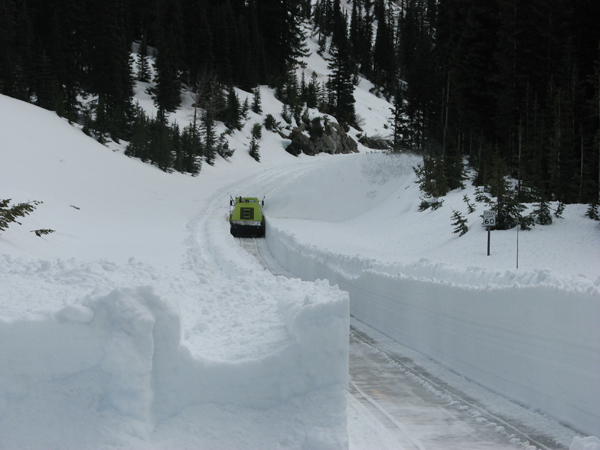It finally feels like spring!
May 31, 2011

Photo courtesy of Washington State Department of Transportation
On May 25 at 12:05 pm the North Cascades Highway opened for the season. Built in 1972, Highway 20 is the most direct connection between Puget Sound and the Methow Valley. Because of the extreme avalanche danger it typically closes across Washington and Rainy passes in late November, reopening in the spring when the DOT can safely clear the winter accumulations.
Record snow levels in the Cascades kept snow removal crews focused on Stevens and Snoqualmie passes until April 11, and then DOT crews had to contend with over 65 feet of snow covering the highway in the avalanche zones. Last year the pass opened on April 16, and the May 25 opening this year was the second latest opening ever.
I find it special to drive across the pass soon after opening. As you can see from the photo above, you’re surrounded by walls of snow, creating an amazing tunnel effect. With the brilliant white snow to either side of you, the deep blue sky above, and the towering mountains in the background, you realize what a special place this is – and only 150 miles from Seattle. For many of us, the late opening of the pass underscores the lousy spring we have experienced. Record rain, nagging cold and only brief respites of sunshine. By the end of May, we were celebrating 60 degree days!
As much as we might complain about our lack of good weather in the Northwest, the rest of the world is suffering infinitely more. Beginning with the Haiti earthquake last year we have seen a succession of natural disasters. Followed closely by earthquakes in Chile, New Zealand and most recently the devastating quake and tsunami in Japan, they have literally shaken the world. In the U.S., record flooding and tornados have left much of the Midwest and South reeling. The pictures and stories are heartbreaking.
It can happen anywhere, and our area certainly is not exempt. Seattle sits in the northeast quadrant of the ‘Ring of Fire’, the Pacific Rim earthquake zone that includes Chile, New Zealand, and Japan. We could experience a +8 Richter scale quake tomorrow, or perhaps 500 years from now, which are relatively speaking only seconds apart on earth’s geologic clock.
It’s incongruous to think that what can provide as much pleasure and natural beauty as the North Cascades could instantly be transformed into a cataclysmic event. Lives would be lost, and none of us would ever be the same. To some extent, I suppose, the power of nature is part of its mystique.
What will happen, geologically and climatically, is largely out of our hands. But we can all do our best to prepare. If you’re a business, now is a good time to update your disaster plan. At home, make sure you have the supplies you need and your family has a plan. Check out the links below to assist you. And if you’re a client of PS&F, know that our own disaster plan is based on being ready to help you should the need arise.
And maybe we won’t complain too much about the rain.
Family Disaster Plan – www.redcross.org/images/pdfs/code/family_disaster_plan.pdf
Business Disaster Planning – http://www.disaster-recovery-guide.com

